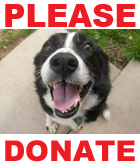
Border Collie Rescue - On Line - Universal Commands

I quote - "Patience is a virtue dogs are born with but very few people ever master." - Unknown
Universal Commands
Introduction to verbal commands and hand signals
| If you are new to this page, please scroll down and read the information below before looking at the commands and hand signals. If you have read and understood the introduction, then click here to go straight to the lists. | ||
| In BCR all verbal commands used are accompanied by hand signals which serve
to emphasise and compliment the instruction. This is of great benefit when training deaf
dogs, but is also useful if a hearing dog is some distance away or conditions are
such that the sound of verbal commands is drowned out by other background noises. Control,
under these circumstances, can be very valuable. |
||
| There is no mystery or weird science involved in training hand signals. Most
dog owners will probably have unknowingly trained their dog to respond to sign simply
because they use particular gestures or facial expressions with certain commands. |
||
| Even
over some distance, a dog is able to differentiate small variations in signals, such as if
the finger is extended or the palm of the hand facing up or down, the arm fully extended
or the elbow bent, so be careful and be consistent. |
||
| Border
Collies are known to be very intelligent, so it is doubly important to be consistent in
the use of any command - verbal or sign. Even a small deviation may confuse the dog or
cause it to think it is getting a different command from the one intended, in which case
it will not react as required. |
||
| This is why the Border Collie is a satisfying breed to train and interact
with - but only if the handler is good and consistent. The breed is notoriously difficult
to train if the handler lacks discipline, is lazy in their approach to training or, as in
some sad cases, is not as intelligent as the dog. |
||
| In a number of the commands we use, the hand signal is very similar, if not
the same, although there is a different verbal command used. The reason for this is that
the result required is simply to attract the dog's attention and get the dog to move in a
particular direction. The the movement of the arm and hand in a particular direction
indicates the principle of what is required to the dog. As in most forms of sign, we are
not trying to get across a complex message, but indicate a meaning which can then be
interpreted according to its context. Dogs are quite 'canny' enough to put all this
together. They sign to each other all the time. |
||
| There are some schools of thought that
insist that the signs should all be very distinctive and you will end up
hopping around on one leg with your arm in the air clutching at invisible
angels just to get the dog to come back to you, if you follow some methods.
But there is little point in making things any more complicated than
necessary to get the required result - this is not rocket science and the
dogs are really quite clever. |
||
| Body posture also plays its part. While issuing the command, if you lean
towards or over a dog it will add an intimidating factor. If you move forward the command
becomes more urgent and imperative. If you move away it implies invitation. If you are
relaxed and upright it will emphasise your confidence and authority. Smiling broadly
always helps to reassure a dog that all is OK and it has got it right. Frowning with teeth
clenched and displayed lets it know things are not satisfactory. |
||
| Unless the dog is deaf, the verbal command is the principal instruction and
the hand signal used as emphasis. If the dog is deaf it will still be able to distinguish
meaning by reading your facial expression as you speak the verbal command (Canine Lip
Reading). By making the hand signal faster and more assertive you can also emphasise the
compulsion of the command. |
||
| So we use signals to get across meaning by a combination of factors used together. - A clear hand signal. - A verbal command with the accompanying facial expression we naturally form when we speak the word. - Our body posture and movement. - The energy we put into the signal to increase emphasis or urgency. | ||
| The following commands are intended to convey a brief instruction to pet
dogs. In BCR we use different commands for certain instructions to working sheepdogs. For
example, with a WSD we do not use the word 'Come' for recall as it may be confused with
'Come Bye', a sheepdog command that means circle clockwise. Instead we would use 'here' or
'here to me'. Instead of 'Leave' we may use 'that'll do' to indicate that the dog should
stop its task and come away. Sheepdog commands are covered elsewhere. Foster Carers and anyone handling dogs within BCR should have a competent grasp of these commands and signs and use them on all BCR dogs, irrespective of what they use on their own dogs. Verbal commands and hand signals should always be used together. |
||
| Click on the command to get a page with larger and additional images and more detailed explanation as to why the command is taught and how we apply it. | ||
In the Breed Advice section of the website we have another Universal Commands section like the one above but with links to further pages with additional images and information about each command.
To visit that section - click here -
There is no backlink so you will need to use the BCR button in one of the page headers to return to the members section.
| List of verbal commands and associated hand signals used in BCR. We
always use the dogs name before the command. |
||
| Verbal Command | Hand |
Signal |
| Sit | Holding your arm straight down at your side you raise the forearm and hand from the elbow, palm up, above dogs head. | 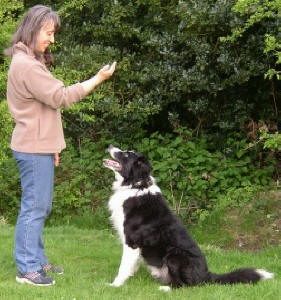 |
| Down | Lower hand, arm extended and palm down, from a horizontal position towards the ground. | 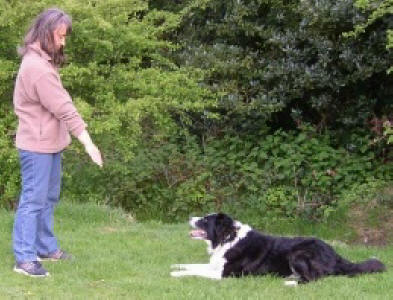 |
| Stay or Wait | Full palm of hand is extended from shoulder height at arms length towards the dog (policeman's stop signal). | 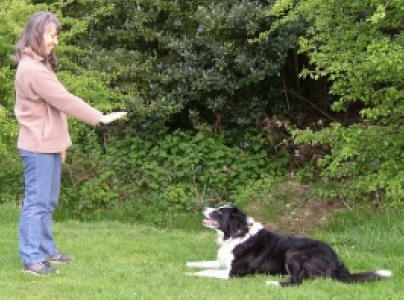 |
| Come | Arms fully outstretched horizontally on each side then brought to meet in front of your stomach. (Angel of the North position to those of you who are familiar). | 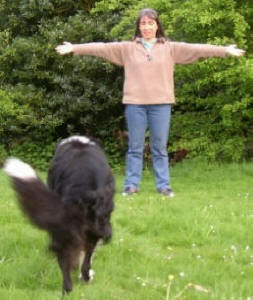 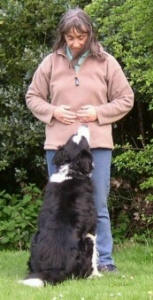 |
| Heel | Dog walks on your left side. Tap left thigh with left hand. From front position, dog comes round your back from right side to left. From back position dog comes in on left. (on or off lead) | 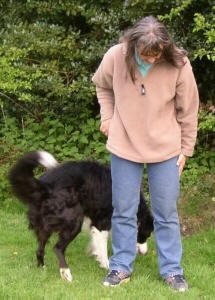 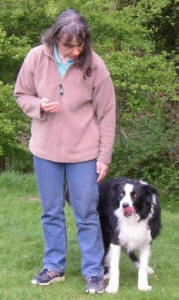 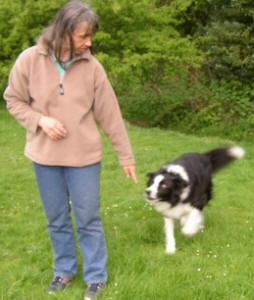 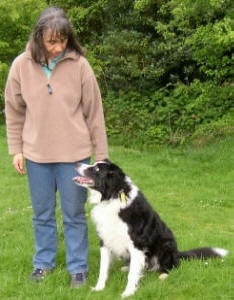 |
| Off | To stop dog jumping up at you, say OFF as he rises to touch you and turn your back on him. Also use to get dog off a chair or other item by pointing away from item with extended arm. It is incorrect to use 'down' as it may confuse. | 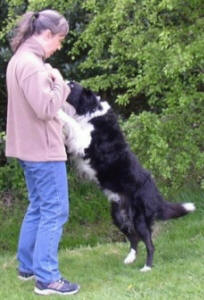 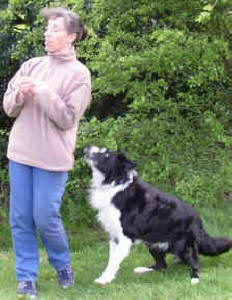 |
| Leave | Wave hand or hands with arms extended towards the dog and away from the object you wish left alone. May be used to stop playing with toys or to interrupt feeding. | 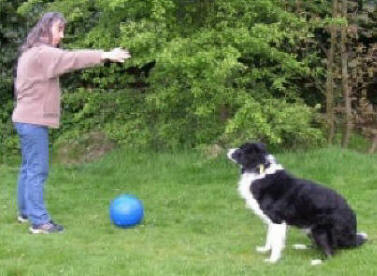 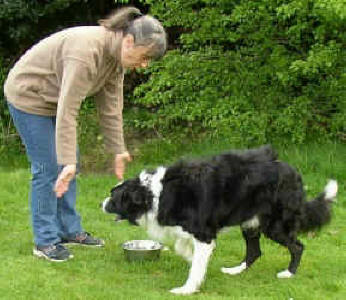 |
| Back | Wave hand from direction of dogs head in the direction you wish him to go, hold position pointing. Repeat to get dog to go further back. To keep dog behind move extended arm backwards, palm flat and facing towards dog. | 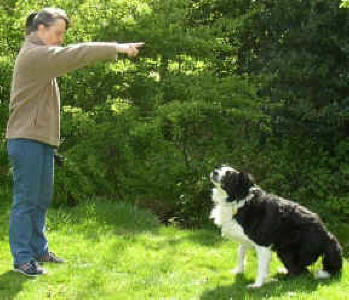 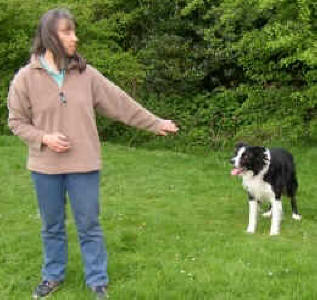 |
| Fetch or Get It | Wave hand from direction of dogs head towards item to be retrieved and point. | 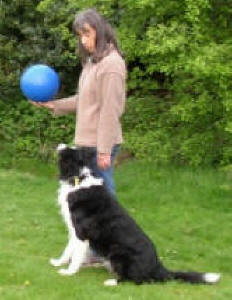 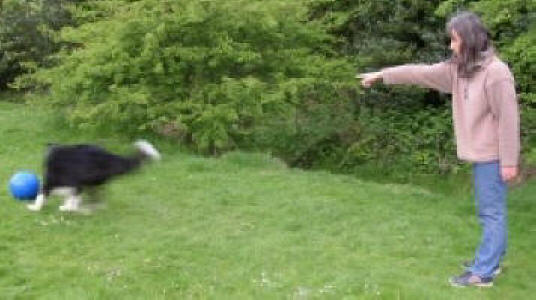 |
| Eat | Point at food bowl, arm and index finger extended.. | 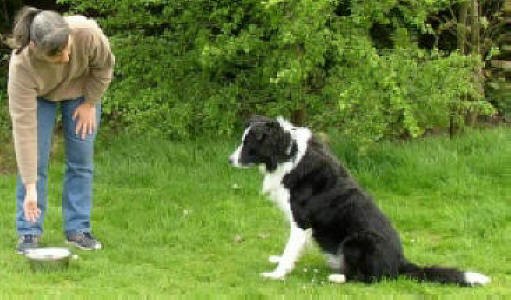 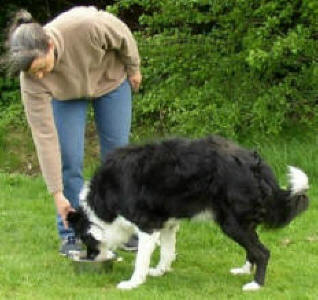 |
| Hold | Place item in dogs mouth and place one hand palm up under the jaw and the other hand palm down over the nose, gently holding jaws tight on item. Step back and show palm of hand as in stay. | 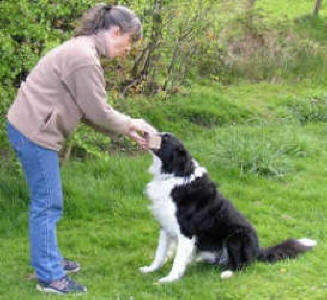 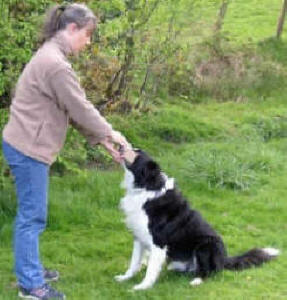 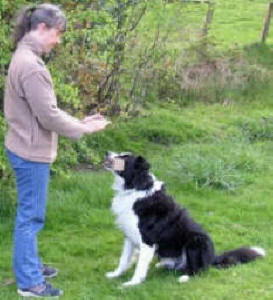 |
| Give | Get the dog to sit first. Offer both hands to each side of the dogs mouth to take item. Grip and gently remove. | 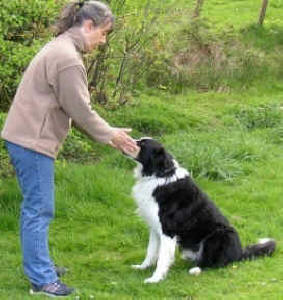 |
| Catch | Pretend to throw with underarm 'Bowling' motion while using other arm extended and palm facing dog in 'stay' command. When you throw remove stay command to free dog to catch object. | 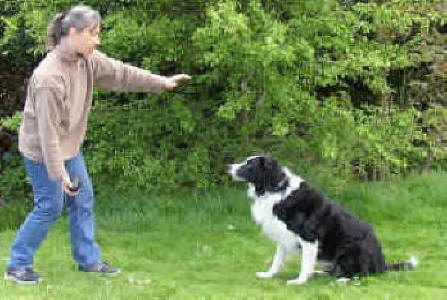 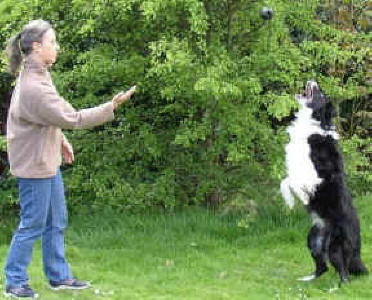 |
Bed |
Point to dogs bed - this should not be used as a punishment - so smile. | Do you really need an illustration for this? |
Quiet |
Waggle extended index finger vertically, from side to side, in front of the dogs face. | Do you really need an illustration for this? |
| Wee or Poo | Arm pointing downward with index finger extended is moved in a circling motion clockwise motion. | 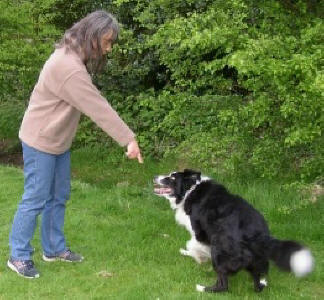 |
| Watch Me | Point to your eyes using one or both hands until the dog makes eye contact. A very useful command to teach a deaf dog. | 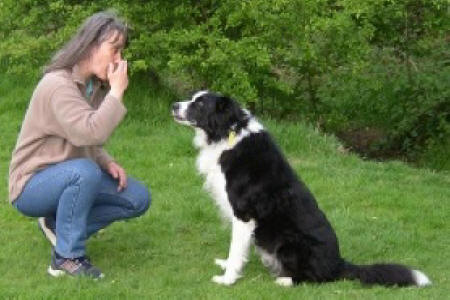 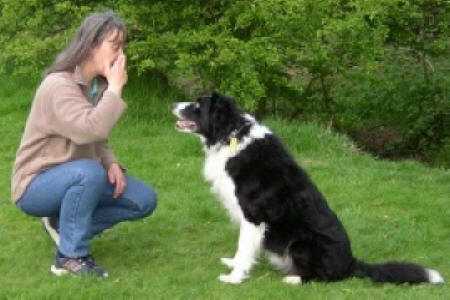 |
In |
Point indoors or towards the item or vehicle you wish the dog to enter with arm and index finger fully extended. | Do you really need an illustration for this? |
Out |
Point outdoors or away from the item or vehicle you wish the dog to leave with arm and index finger fully extended. | Do you really need an illustration for this? |
| No | Point index finger straight at dogs head with elbow bent. | 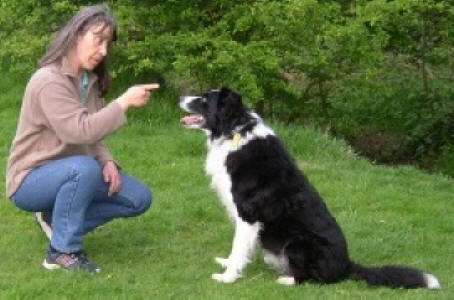 |
| Go Free | Both arms thrown up in the air together and extended in an exuberant manner. | 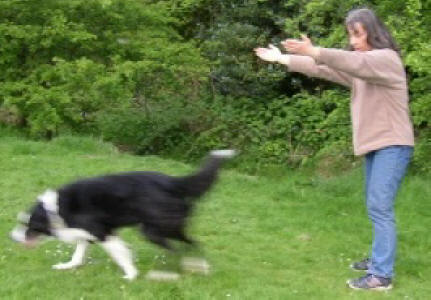 |
In the Breed Advice section of the website we have another Universal Commands section like the one above but with links to further pages with additional images and information about each command.
To visit that section - click here -
There is no backlink so you will need to use the BCR button in one of the page headers to return to the members section.

